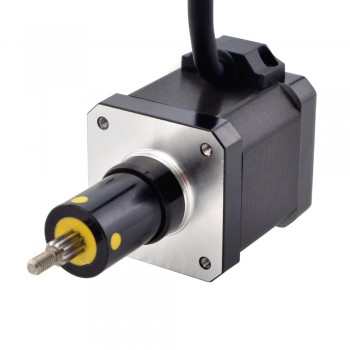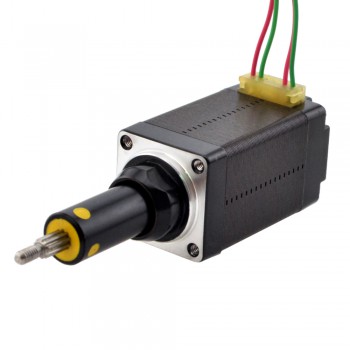How to install the linear stepper motor properly?
2025/07/16 17:13
瀏覽51
迴響0
推薦0
引用0
1.What is a linear stepper motor?
A linear stepper motor, also known as a linear stepper actuator, is a device that converts rotational motion from a stepper motor into linear motion. Its a type of electric motor designed to move in a straight line, unlike traditional rotary stepper motors which rotate. These motors are particularly useful in applications requiring precise and controlled linear movement, such as robotics, automation, and medical devices.
2.Working principle os linear stepper motor
Linear stepper motors convert electrical pulses into precise linear motion using electromagnetism. They achieve this by using a forcer (moving part) with electromagnets and a platen (stationary part) with precisely spaced teeth or magnetic poles. When electrical pulses are applied to the forcers coils, magnetic fields are created, causing the forcer to move in discrete steps along the platen.
3.Main structure of linear stepper motor
1.Stator:The stator is a crucial component of a linear stepper motor. It serves as the stationary part of the motor and contains electromagnetic coils responsible for generating the magnetic fields necessary for the motors operation. The stator is typically composed of several individual coils arranged in a linear configuration. These coils are wound with copper wire and are designed to produce magnetic fields when an electrical current passes through them.
2.Rotor:The rotor is the moving part of a linear stepper motor and plays a pivotal role in generating linear motion. It interacts with the stators magnetic fields to produce movement. The rotor is typically equipped with a permanent magnet or magnetic teeth, which align with the changing magnetic fields generated by the stator coils.
3.Lead Screw or Ball Screw:To convert the rotational motion of the rotor into linear motion, linear stepper motors incorporate a lead screw or ball screw mechanism. These mechanisms enable the linear translation of the rotors movement along the screw axis. The lead screw consists of a threaded shaft and a nut, while the ball screw incorporates recirculating ball bearings between the screw and nut.
4.Bearings:Bearings are crucial components in a linear stepper motor as they provide support and smooth movement. Linear stepper motors typically utilize linear bearings, such as linear ball bearings or linear roller bearings.
5.Control and Drive Electronics:Linear stepper motors require control and drive electronics to regulate their operation. The control system sends electrical pulses to the stator coils in a specific sequence and timing to achieve the desired linear motion. The drive electronics amplify and regulate the electrical signals, ensuring precise control over the motors movement.
6.Power Supply:A power supply is an essential component of a linear stepper motor system. It provides the necessary electrical power to drive the motor and enable its operation.

4.Tips for Installing linear stepper motors
1. Determine the Mounting Orientation:Before installing the linear stepper motor, it is essential to determine the mounting orientation. Depending on your application requirements, you may choose between vertical and horizontal mounting. This decision can affect the motors performance, especially in terms of load capacity and overall stability.
2. Ensure Proper Alignment:Aligning the linear stepper motor accurately is essential to prevent any misalignment issues that can lead to reduced performance or premature wear. Before installation, ensure that the motor shaft and driven load are correctly aligned. Use appropriate tools such as dial indicators to check for any misalignment, and make the necessary adjustments to achieve the desired alignment.
3. Establish a Secure Mounting Platform:To ensure the stability and longevity of the linear stepper motor, it is crucial to establish a secure mounting platform. A stable and sturdy base helps to minimize vibrations and any potential movement that could interfere with the motors operation. Depending on your application, choose a suitable mounting platform such as a rigid table, frame, or bracket.
4. Verify Electrical Connections:Before installing the linear stepper motor, always double-check the electrical connections. Ensure that the power supply, motor driver, and motor wiring are properly connected according to the manufacturers specifications. Inadequate or incorrect electrical connections can result in motor malfunctions or damage. It is also essential to verify that the voltage and current ratings of the motor match the requirements of your application. Failure to do so may result in performance degradation or permanent damage to the motor.
5. Take Precautions for Heat Dissipation:Linear stepper motors generate heat during operation, especially when subjected to high current or prolonged use. To prevent overheating, it is crucial to consider proper heat dissipation measures during the installation process. Ensure that the motor has adequate airflow around it, and if necessary, install additional cooling mechanisms such as fans or heat sinks. Adequate heat dissipation helps to maintain the motors temperature within the acceptable range, improving its overall performance and reliability.
你可能會有興趣的文章:
- What are the selection principles of hybrid stepper motors?
- How to achieve high-precision positioning of bipolar stepper motors
- Working principle and maintenance method of permanent magnet stepper motor
- Explanation of technical points of integrated stepper motors
- Speed regulation method and selection conditions of AC gear motor
- Operating characteristics of brushless DC motors
限會員,要發表迴響,請先登入



